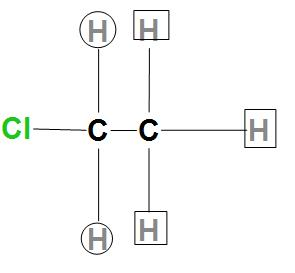
How can I determine NMR splitting pattern?
Answer
549.9k+ views
Hint As we know that NMR gives us the information about how many how much neighbouring hydrogens exit for an individual or for a group of hydrogen atoms. It is basically found that if there is one hydrogen present on the adjacent atoms, then resonance will split into two peaks having equal size.
Complete answer:
- In order to find the NMR splitting pattern in hydrogen atoms, we will first count the adjacent hydrogen atoms present, and then will add one to that number. Let us consider an example of $C{{H}_{2}}ClC{{H}_{3}}$, we will first draw its structure as:

- Here, we can see that there are three identical hydrogen atoms that are marked as square, and two hydrogen atoms that are circled are adjacent to the square hydrogens. So, they are found to exhibit a quartet that is (4 peak, 3+1) splitting pattern.
- For the square hydrogen, we can see they are adjacent to the two same hydrogens that are circled, so it is found that their splitting pattern is triplet.
Note:
- As we know that if there were no hydrogens present on the adjacent hydrogen atoms, then the resonance will remain a single peak.
- And if there were two hydrogens present on the adjacent hydrogen atoms then the resonance will split into two peaks having equal size, called doublet.
- Whereas, if there were three hydrogens present on the adjacent hydrogen atoms then the resonance will split into three peaks having equal size, called a triplet.
Complete answer:
- In order to find the NMR splitting pattern in hydrogen atoms, we will first count the adjacent hydrogen atoms present, and then will add one to that number. Let us consider an example of $C{{H}_{2}}ClC{{H}_{3}}$, we will first draw its structure as:

- Here, we can see that there are three identical hydrogen atoms that are marked as square, and two hydrogen atoms that are circled are adjacent to the square hydrogens. So, they are found to exhibit a quartet that is (4 peak, 3+1) splitting pattern.
- For the square hydrogen, we can see they are adjacent to the two same hydrogens that are circled, so it is found that their splitting pattern is triplet.
Note:
- As we know that if there were no hydrogens present on the adjacent hydrogen atoms, then the resonance will remain a single peak.
- And if there were two hydrogens present on the adjacent hydrogen atoms then the resonance will split into two peaks having equal size, called doublet.
- Whereas, if there were three hydrogens present on the adjacent hydrogen atoms then the resonance will split into three peaks having equal size, called a triplet.
Recently Updated Pages
Why are manures considered better than fertilizers class 11 biology CBSE

Find the coordinates of the midpoint of the line segment class 11 maths CBSE

Distinguish between static friction limiting friction class 11 physics CBSE

The Chairman of the constituent Assembly was A Jawaharlal class 11 social science CBSE

The first National Commission on Labour NCL submitted class 11 social science CBSE

Number of all subshell of n + l 7 is A 4 B 5 C 6 D class 11 chemistry CBSE

Trending doubts
What is meant by exothermic and endothermic reactions class 11 chemistry CBSE

10 examples of friction in our daily life

One Metric ton is equal to kg A 10000 B 1000 C 100 class 11 physics CBSE

1 Quintal is equal to a 110 kg b 10 kg c 100kg d 1000 class 11 physics CBSE

Difference Between Prokaryotic Cells and Eukaryotic Cells

What are Quantum numbers Explain the quantum number class 11 chemistry CBSE




